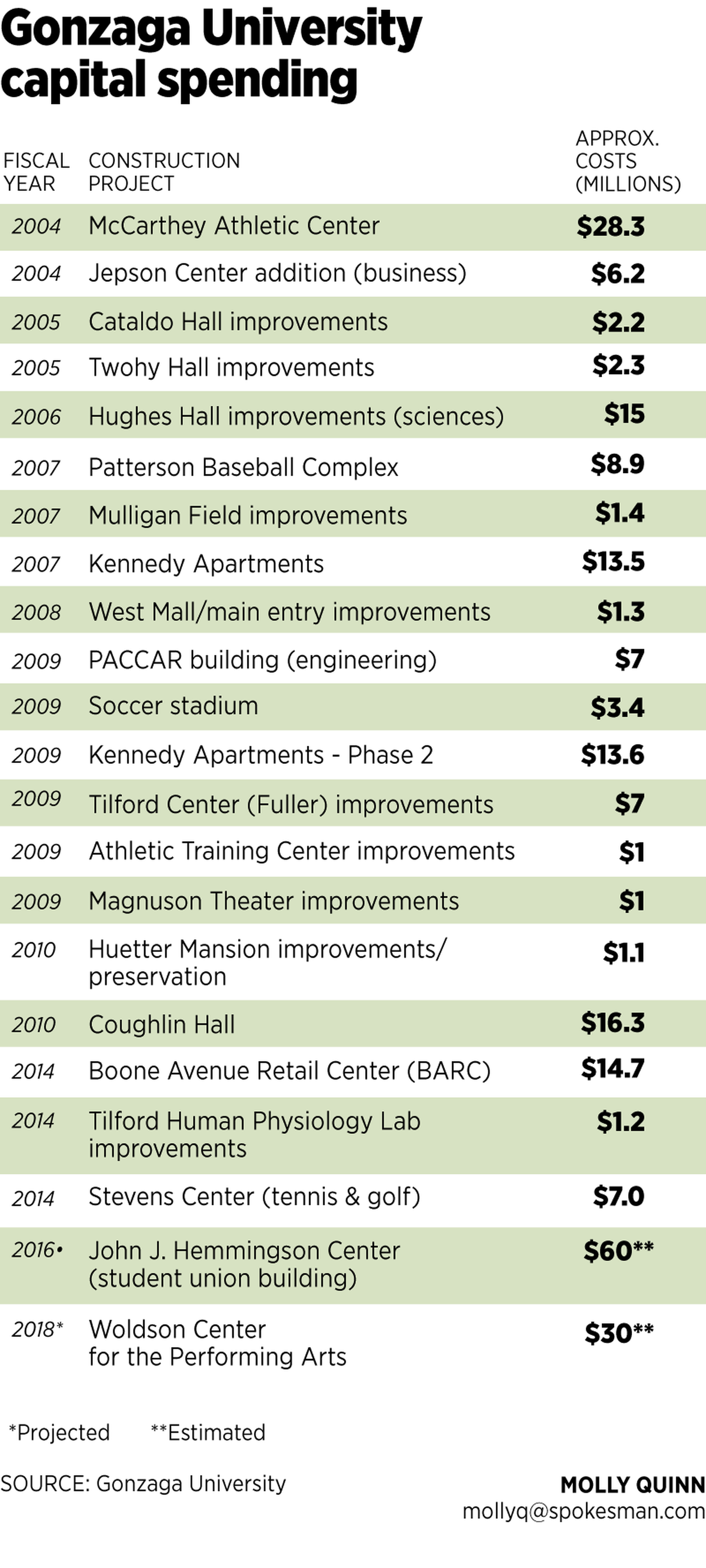Gonzaga University to boost endowment in $250 million capital campaign

Gonzaga University announced Thursday it intends to raise $250 million to pay for new buildings, scholarships and expanded programs.
It’s the most ambitious financial goal in school history.
The campaign began quietly months ago and has collected $183 million so far, said Gonzaga President Thayne McCulloh.
“This campaign is about our future,” he said.
The money will position the university to become a more integral part of the Spokane community at a time when post-secondary education is branching off into non-traditional approaches such as online learning.
About 23,000 individual donations have been made so far by GU supporters and alumni.
McCulloh announced the campaign - called “Gonzaga Will” – at a special gathering Thursday evening of hundreds of GU faithful at the Davenport Grand Hotel ballroom.
He said the off-campus event was planned to demonstrate GU’s commitment to engagement with the wider community and abroad.
The largest gift so far is an estimated $55 million bequest from the estate of Myrtle Woldson, one of Spokane’s most noted philanthropists who died last year at age 104.
Among her numerous philanthropic efforts, Woldson is remembered in Spokane for her $3 million gift about 15 years ago to jump start rehabilitation of what is now known as the Martin Woldson Theater at the Fox, named after her pioneer father.
The Woldson gift to GU includes three prized waterfront properties in downtown Seattle worth tens of millions of dollars.
Woldson, a longtime GU supporter, believed that education was the venue for opening doors to young people, McCulloh said.

She specifically asked that a large portion of the money be used for a student scholarship fund to bridge the affordability gap for talented students from middle- and lower-income families, McCulloh said.
The university president said the scholarship fund – pegged at $25 million – could help hundreds of students every year, and that the university plans to position the assets for a longterm performance.
Woldson’s bequest also is paying for construction of a new Myrtle Woldson Performing Arts Center at an estimated cost of $30 million. It will be located on the west side of campus and is now in the design phase.
The university president said that he met personally with Woldson several years ago and communicated with her often even as her health declined. He said he wanted to ensure that her gift met her objectives.
“She really saw Gonzaga as the place she wanted to make an impact,” McCulloh said in an interview earlier this week. Plus, she placed a lot of her trust in GU, he said.
According to the Chronicle of Philanthropy, her bequest is second largest gift to a college or university in Washington state history.
The money was not her only contribution.
“Miss Woldson was an avid member of the Gonzaga family – a proud Zag who attended University events and loved to cheer on the Bulldogs at basketball games,” McCulloh said. “She made generous gifts to the Jundt Museum Art Endowment, athletics and student scholarships over the years.”
The capital campaign comes at a time when GU has enrolled more students and embarked on a construction effort.
Enrollment has climbed from 6,377 in 2005 to 7,491 this year.
The projects spanning the past 11 years include the McCarthey Athletic Center in 2004, Hughes Hall improvements in 2006, Patterson Baseball Complex in 2007, PACCAR Building in 2009, Kennedy Apartments second phase in 2009, Coughlin Hall in 2010, the Boone Avenue retail center in 2014 and the new John J. Hemmingson Center.
Prior to the new capital campaign, GU’s total endowment was $165 million, which is seen as low compared with comparable universities, said Mary Joan Hahn, GU director of community and public relations.
McCulloh outlined five objectives for use of the new funds.
Opening access to the university through scholarships and then using some of that money to keep students on a career track is a top goal.
Secondly, the university president wants to expand what he calls global engagement by developing partnerships abroad and drawing international students to GU.
A third goal is to enhance academic innovations and expand space for engineering and science education. He said he wants GU to explore and develop hybrid academic disciplines that cross traditional boundaries in what is a growing approach to advancement.
In a fourth objective, GU is launching new community engagement efforts, including its current effort to map neighborhood assets in Spokane.
A fifth goal is to create more endowed professorships linked to specialized learning.
Those goals encompass GU’s “institutional vision,” which can also be described as positioning Gonzaga to remain relevant in a changing world.